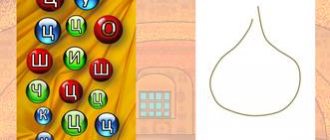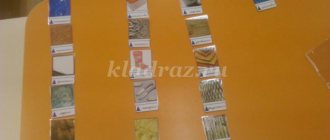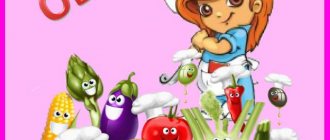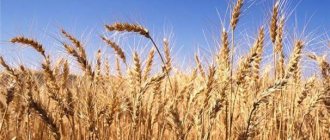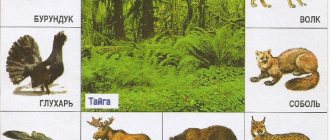Elena Pashkova
Summary of the lesson “Vegetables” in the preparatory group
1. Expanding the vocabulary on the topic: “ vegetables ”
,
2. Exercise in the use of phrases,
3. Formation of the general concept of “ vegetables ”
,
4. Development of fine motor skills, attention, memory,
5. Exercise in gender agreement between adjectives and nouns.
Pictures on the topic: “ vegetables ”
, dummies
of vegetables hedgehog
massagers , symbols: “tops”,
“roots”
, silhouettes of
“grandfather”
and a bear, real
vegetables : cabbage, cucumber, tomato, carrots, beets.
Presentation for the lesson
Download presentation (688.4 kB)
Attention! Slide previews are for informational purposes only and may not represent all the features of the presentation. If you are interested in this work, please download the full version.
Goals:
- Strengthen children's knowledge about vegetables.
- Strengthen the ability to form the diminutive form of nouns.
- Strengthen children's ability to coordinate numerals with nouns.
- Develop logical thinking, attention, memory of children.
- Develop fine motor skills.
- Develop general speech skills.
- Expand your vocabulary on the topic.
Educator. Children, listen carefully to the poem.
There is a vegetable garden under the window - A lot of vegetables grow: Pumpkin, turnips and garlic, Onions, cabbage, zucchini. You can’t name everything right away - Maybe you can find more?
Educator. List the vegetables mentioned in the poem. (Children's answers). Educator. Children, look at the picture (Slide 3) and name the vegetables that you forgot to mention in the poem. (Children's answers). Educator. I'll start, and you continue. In the garden there are beds with carrots and cucumbers. (Children's answers).
Autumn has gifted you and me with a generous hand, And riddles have grown in every garden bed.
This vegetable is round in shape, yellow in color, and tastes sweet. (Pena) (Slides 4-5). This vegetable is oval-shaped, long, green, rough, crunchy, and sweet in taste. (Cucumber) (Slides 6-7). This vegetable is round in shape, yellow in color, juicy, and bitter in taste. (Bow) (Slides 8-9). This vegetable is oval-shaped, long, orange in color, juicy, crispy, and sweet in taste. (Carrot) (Slides 10-11). This vegetable is round in shape, burgundy in color, and tastes sweet. (Beets) (Slides 12-13).
Educator. (Slide 14)
On a warm sunny day, a thick zucchini lay warming itself in a garden bed. And I felt sorry for plucking it - But it can’t spend the winter in the garden.
Educator. What other vegetables can we pick from the garden? (Children’s answers: tomatoes, cucumbers, peas, eggplants) (Slides 15-16). Educator. What vegetable can we dig up? (Potatoes) (Slides 17-18). Educator. What vegetables do we pull out of the ground? (Carrots, beets, turnips, onions, radishes) (Slides 19-20). Educator. What vegetable can we cut? (Kanycmy, parsley, dill) (Slides 21-22). Educator. Let's name what actions we perform in order to collect vegetables? (Children's answers) (Slide 23). Educator. Well done! You know what you need to do to harvest. It's time to go to the garden to collect the harvest.
Physical school
(Children perform movements in accordance with the words spoken by the teacher).
We dug up potatoes, picked cucumbers from the ridge, pulled out all the carrots, and cut cabbage deftly. And they brought you a gift in a basket from the earth.
Educator.
We have a large vegetable garden, and the harvest here is good. One two three four five. We start collecting vegetables in the basket.
Educator. Look at the tomatoes (Slide 24). How are they different from each other? (Children's answers - size, small tomato, bigger, even bigger, even bigger, big tomato). Educator. We need to count the tomatoes by following the rule. And the rule is this: the larger the tomato, the louder the voice should be when counting. Look how I will do it.
(The teacher, on one exhalation, counts to 5 with a louder voice).
Educator. Now show me how you do it.
(Children perform an exercise to develop speech breathing and voice strength).
Educator. And now I will put vegetables in the basket (Slide 25). One tomato, two tomatoes, three tomatoes, four tomatoes, five tomatoes. Now put the vegetables in the basket, you children.
1st child: one cucumber, two cucumbers, three cucumbers, four cucumbers, five cucumbers. 2nd child: one turnip, two turnips, three turnips, four turnips, five turnips. 3rd child: one beet, two beets, three beets, four beets, five beets. 4th child: one carrot, two carrots, three carrots, four carrots, five carrots.
Educator. This is the harvest of vegetables we collected (Slide 26). Educator. Children, look at this drawing and tell me what vegetables are hidden here? (Slide 27). Educator. Now, children, find this drawing in your notebooks. (Children open the desired page). Children, call me affectionately:
Educator. Children, let's get our fingers ready for work.
Finger gymnastics “We have grown garlic. »
Read also: Nailers pneumatic nail guns
For each stressed syllable, the child kneads the phalanges of one finger, the direction of the massage movements is from the nail phalanx to the base of the finger.
We grew garlic, the index finger of the left hand. Pepper, tomato, zucchini, the middle finger of the left hand. Pumpkin, cabbage, potatoes, the ring finger of the left hand. Onions and a little peas. little finger of the left hand We collected vegetables, little finger of the right hand We treated our friends with them, ring finger of the right hand Fermented, ate, salted, middle finger of the right hand We took them home from the dacha, index finger of the right hand Goodbye for the year, thumb of the left hand Our friend is the vegetable garden! right thumb
Educator. What vegetable is the riddle about?
It is round and red, like the eye of a traffic light. There is no juicier among vegetables. (tomato)
Educator. Trace the outline of the tomato with your finger. (Children circle). Now color the tomato, not paying attention to the lines crossing its outline. (Children color the tomato). Trace the outline of the carrot with an orange pencil, and trace the outline of the cucumber with a green pencil. (Children complete tasks). In the final part of the lesson, the teacher sums it up, asking the children to briefly repeat what they did today.
Literature:
- Krupenchuk O.I. Teach me to speak correctly! Speech therapy manual for children and parents. – St. Petersburg: Litera Publishing House, 2005.
- Osmanova G.A., Pozdnyakova L.A. Games and exercises for developing general speech skills in children. – St. Petersburg: Karo, 2007.
- Vasilyeva S.A. Workbook on speech development for preschoolers. – M.: School Press, 2002.
- Vasilyeva S.A., Miryasova V.I. Thematic dictionary in pictures: World of plants: Fruits, vegetables. (Program “I am a man”) - M.: School Press, 2005.
- Nishcheva N.V. System of correctional work in a speech therapy group for children with general speech underdevelopment. – St. Petersburg: Detstvo-Press, 2003.
Elena Pashkova
Summary of the lesson “Vegetables” in the preparatory group
1. Expanding the vocabulary on the topic: “ vegetables ”
,
2. Exercise in the use of phrases,
3. Formation of the general concept of “ vegetables ”
,
4. Development of fine motor skills, attention, memory,
5. Exercise in gender agreement between adjectives and nouns.
Pictures on the topic: “ vegetables ”
, dummies
of vegetables hedgehog
massagers , symbols: “tops”,
“roots”
, silhouettes of
“grandfather”
and a bear, real
vegetables : cabbage, cucumber, tomato, carrots, beets.
A series of speech therapy classes on the lexical topic “Vegetables”.
Kirillova Yu., speech therapist
.
TOPIC “VEGETABLES” Goal: - expansion and activation of the dictionary. Tasks: form the plural of nouns; -learn to form nouns with diminutive suffixes; – learn to select adjectives for nouns; – develop phonemic awareness; – develop coordination of speech with movement, work on the tempo and rhythm of speech; – develop fine motor skills; – to form visual-object gnosis.
Equipment: pictures of vegetables, a ball, material for the game “Where is whose shadow?” Progress of the lesson:
1. Org. moment. Finger gymnastics “CABBAGE” Speech therapist. Guess the riddle: She grows in your garden bed, Dressed in noisy silks. We are preparing tubs for her and half a bag of coarse salt. Children. Cabbage! Speech therapist. Let's prepare cabbage for the winter.
Knock! Knock! Knock! Knock! There is a knock in the house. We chopped the cabbage, ground it, salted it, and stuffed it tightly into a tub. Everything is fine with us now. (Rhythmic strikes with the edges of the palms on the table.)
(Grasping movements with both hands.) (The index and middle fingers rub against the thumb.) (Hit the table with both hands.) (Shake off the hands.)
2. Introduction to the topic. (pictures depicting vegetables) Name all this (pictures depicting vegetables) in one word. (Vegetables) What other vegetables do you know? Where do vegetables grow? (on the ground, underground) How to collect vegetables that grow on the ground. on a bush? (pluck, cut) How do they collect vegetables that grow underground? (dig up, 3. pull out)
3. Game “Choose the sign” Carrots (beets, turnips, cabbage) – (which one?) – tasty, crispy, orange, large, round, healthy, juicy, large, small…. Onion (cucumber, tomato, garlic, zucchini) - (which?) - tasty, crispy, red, large, round, healthy, juicy, large, small, bitter….
4. Game “Big-small” Tomato-tomato carrot-carrot Cucumber-cucumber pumpkin-pumpkin Onion-onion beet-beet Garlic-garlic cabbage-cabbage Peas-peas potato-potato
5. Game “One - Many” Tomato - tomatoes Cucumber - cucumbers Pumpkin - pumpkins Zucchini - zucchini Eggplant - eggplant
6. Physical education lesson “Harvest”. Let's go to the garden and collect the harvest. (marching) We will drag carrots (“Drag”) And dig up potatoes. (“They’re digging”) We’ll cut a head of cabbage, (“Cutting”) Round, juicy, very tasty, (They show the circle with their hands, 3 times.) We’ll pick a little sorrel (“Tearing”) And we’ll go back along the path. (marching)
7. Game “Name the juice, salad.” Carrot juice - carrot Cabbage juice - cabbage Beet juice - beet Cucumber salad - cucumber Potato salad - potato Pea soup - pea Zucchini caviar - squash 8. Game “Where is whose shadow?” (find the shadows of vegetables)
Dream Interpretation - Earth
“go underground” hide, hide.
“to be closer to the earth” stability, solidity, balance. “May you rest in peace” peaceful death. “Falling through the ground” is a curse, guilt, shame.
“favorable soil” luck. “Wipe from the face of the earth” to destroy.
“to knock the ground out from under someone’s feet” to deprive someone of their position or confidence. “Burying talent in the ground” is ruining, not using abilities, putting things off. “Test the waters” to get your bearings, to find out the situation. “To dig the ground (with your nose)” to actively act, to try your best. “The earth is disappearing from under your feet” is a strong emotional experience.
“the earth cannot bear him” about a very bad person. “To lose (or feel) the ground under your feet” to gain confidence or lose life goals and guidelines. “To fall or fall on fertile ground” is success, the flowering of one’s abilities.
“down to earth person”, realistic person, everyman.
"mother-earth-nurse." “Mother Earth gave, Mother Earth took” life cycle of human life. See add. dig .
How to quickly and easily dig up a garden
To quickly dig up a garden, it is advisable to adhere to the following technology:
- First, use pegs and a stretched rope to mark the approximate boundaries of the future vegetable garden.
- Then a trench is dug along one of the sides, approximately the depth of a shovel. The width of the trench in this case is also equal to the width of the shovel blade.
- All extracted soil is immediately freed from weed roots and possible mechanical additives (stones, debris).
- The earth from the first trench is put in a separate place so that it can be used later.
- Parallel to the first one, the next trench is dug, the earth from which is used to fill the previous trench.
- According to this scheme, they continue to dig up the ground until the marking of the area prepared for the garden is completed.
- Then the last trench is filled with pre-set earth from the first trench.
Dream Interpretation - Earth
Land as soil - financial situation: plowed - to good prospects, loose - to prosperity, dried - to losses; rocky - unsuccessful deal; overgrown - to a profitable investment; frozen - temporary complications in business; subject to erosion - a break with business partners will put you in a difficult situation. Cultivating the land means changes at work. Digging yourself - success will come to you through titanic work. Digging a hole - with your inflexible character you are creating trouble for yourself. Trample the ground - someone is trying to take your position through cunning and deception. Seeing the land being plowed means you will soon be offered a profitable job. Planting beds in the garden means your salary will be increased. Wearing it means honor and respect among colleagues. Water - you will become an object of intrigue and gossip from envious people. Weed - management is considering you as a candidate for dismissal.
Imagine fertilized, moist, rich, fertile soil. Throw grain at it.
Land as property - changes in family life. Buying a plot of land is a new addition to the family. Owning a plot of land will be a very profitable family business. Advertise the sale of land - constant quarrels can lead to divorce. Selling a plot of land means changing your living conditions at a loss. Donating a plot of land means improving living conditions. Receive an inheritance - receive news of the death of a relative.
Imagine that you own a huge plot of land that has no end or edge. Mentally walk through your property, admire the beauty of the landscape, inhale the aroma of flowers. Experience a feeling of peace and tranquility for your destiny and the destiny of your loved ones.
Earth as a planet - peace of mind, security. Seeing the Earth from space means you will be able to understand the current situation by looking at it from the outside. Discover new lands - be careful when choosing new friends. To see the long-awaited land from a ship - you will receive wise advice and support. Desert island - you are burdened by loneliness.
Remember that part of the planet that struck you with special beauty, no matter whether you saw it in a picture, on TV, or with your own eyes. Try to examine the details in great detail and enjoy the charm of the world around you.
Slicing knives
To make the table setting look like in professional photos, you need to use curly knives for cutting vegetables and fruits.
The variety of such devices guarantees original cutting of fruits. Having a sharp blade is the main requirement for a kitchen knife for curly cutting. This will allow you to accurately cut complex shapes.
Straw slicer
Slicers for cutting vegetables into strips differ in their design. They can take the form of a straight or cone-shaped grater, as well as a peeler knife with a grooved blade. Slicers are used only for cutting hard vegetables, since soft fruits can be crushed. This device is used to cut potatoes for frying.
Slicer for portion cutting of vegetables.
Long strips for Korean carrots and vegetable spaghetti are made using a cone-shaped grater, which has only one hole for slicing. The manual machine is small in size and safe to use. Due to the lack of a handle, the kitchen tool is uncomfortable to hold in your hand, so you will need to get used to it .
Long spiral machine
For beautiful spiral cutting, use a long spiral machine. This device takes up more space and is fixed on the countertop. The fruit is clamped in a special device. When the handle is rotated, the spiral blade cuts into the vegetable. At the end of the process, the fruit is removed from the machine and the resulting vegetable spiral is straightened.
The spiral vegetable cutter is completely mechanical, so it is easy and safe to clean.
For a wavy edge
You can decorate various dishes when setting the table with vegetables with wavy edges. For slicing, special knives of the appropriate profile are used. The most common of them is shaped like a hatchet. It features a wide profile with a wavy surface. Using this knife, you make a zigzag along the edge of a piece of vegetable. Use the device with care to avoid cutting yourself.
Device for wavy cutting of vegetables.
Forms for creating flowers
You can decorate dishes with flowers from vegetables if you cut them into special shapes. Such devices are distinguished by the presence of one sharp edge. The molds can be used to cut even hard vegetables. Tools have different shapes and sizes. The cutting edge is sharp, but if it becomes dull, you will not be able to sharpen it yourself.
Dream Interpretation - Earth
Plowed land means wealth.
Land overgrown with weeds means poverty.
The ground thawed after frost is good luck.
Abandoned land means losses and troubles.
Walking on the ground and checking its looseness - the upcoming new business can be very risky.
Plowing the land in a dream, or plowing yourself is a sign that you will soon be offered a profitable job, promoted or increased in salary.
Cultivate the land - to success in business, profit and material well-being.
Read also: A hammer for working in space is an important quality
The soil has been eaten away by erosion - you can expect conflicts in the family, quarrels over trifles.
Your own plot of land - an interesting job awaits you, which will bring you both moral satisfaction and material profit.
Someone else's plot of land - an unsuccessful or ill-considered waste of money awaits you. Such a dream may also mean your inaction, unwillingness to make additional efforts to achieve your goal.
Protect your garden from diseases and pests
Preserving the integrity of the vegetable is the main task facing the gardener who grows crops for long-term storage. Compliance with all agrotechnical requirements will protect your crop from diseases. Don't forget about pest control. Even a small damage to the skin will lead to premature drying of the vegetable. And the appearance of pests like mole crickets, wireworms or mice on your site can lead to a real disaster
- The most dangerous vegetable diseases - photos, descriptions and control measures in tables.
We fight plant diseases together with you.
Dream Interpretation - Earth
Beautiful, fertile soil in a field or garden is a sign of wealth and prosperity.
Cultivating such land is a sign of profit, a good harvest.
Often for a man, the earth is a symbol of his marriage and family life.
Well-groomed land means a happy marriage, etc.
Rocky, dry, barren land is a very bad dream; it foretells failure and poverty.
Falling to the ground from a great height means shame, humiliation, poverty.
Lying on the ground means minor troubles.
Getting your hands or clothes dirty with heavy, sticky soil means illness or the need to leave your home.
If the earth moves in a dream, it means happy changes, and if you find yourself in underground passages and walk there for a long time, wealth and fame will be very hard to come by.
When you dream that you and the crew saw the long-awaited land on a ship in the ocean, this is a symbol of unexpected wonderful opportunities that will appear in your life.
What do they dig up with a shovel in the vegetable garden?
Elena Pashkova
Summary of the lesson “Vegetables” in the preparatory group
1. Expanding the vocabulary on the topic: “ vegetables ”
,
2. Exercise in the use of phrases,
3. Formation of the general concept of “ vegetables ”
,
4. Development of fine motor skills, attention, memory,
5. Exercise in gender agreement between adjectives and nouns.
Pictures on the topic: “ vegetables ”
, dummies
of vegetables hedgehog
massagers , symbols: “tops”,
“roots”
, silhouettes of
“grandfather”
and a bear, real
vegetables : cabbage, cucumber, tomato, carrots, beets.
Collection rules
In addition to taking into account the growing season and the number of approaches for each crop, there are certain nuances of collection. The quality of vegetables is affected by harvest time and weather conditions.
Most fruit crops harvested in wet weather quickly spoil
General recommendations:
- In clear weather, long-lasting root crops are cut and dug up. A wet product spoils faster than a dry one.
- Vegetables that go to the cellar are collected at the stage of technical maturity. This extends the storage period.
- Crops harvested on a rainy day have fewer beneficial elements, especially potassium.
- Legumes should be harvested after rain or in the morning, when the dew has not yet disappeared. Otherwise, the fruits will crumble.
- It is advisable to do the planned collection of vegetables early in the morning. During the day in the sun, they lose their taste.
By following these instructions, you can enjoy fresh produce throughout the cold season.
It is advisable to cut vegetables for jams at the stage of biological maturity
types of food | Dictionary
with word definitions, example sentences and quiz
Almost everything we eat comes from plants, animals, birds, fish and other sea creatures such as shellfish . We can eat the edible parts of many plants, such as roots and leaves, as well as what plants produce, such as fruits and seeds . We can also eat various parts of animals, as well as products produced by animals, such as milk. In many parts of the world, people also eat insects and the things they produce, such as honey .
Before the development of agriculture , people obtained food from the plants and animals of the surrounding world. They dug up roots, collected fruits and seeds, hunted and captured animals and birds, and used spears and nets to catch fish. They also collected shellfish and other seafood , as well as insects and bird eggs, and in many parts of the world people still do all of this.
About ten thousand years ago, agriculture began to develop when people in the Middle East, Asia and South America began to grow plants and domesticate animals and birds. They grew grasses that produced grains such as rice and wheat, and cultivated plants that produced vegetables, nuts and beans . They also grew fruit trees and kept poultry heads for meat and eggs and raised animals for meat and milk, and about eight thousand years ago people also began producing dairy products such as cheese and yogurt from sheep's and goat's milk.
As agriculture developed, farmers began to produce more and more different types of food, and we now see a huge range of products in supermarkets. Find out more about all these types of food by visiting the pages below:
agriculture (noun): agriculture, incl. growing food crops and raising animals - If you study agriculture, you will learn about the methods and science of farming.
bean (noun): an edible seed, often bud-shaped, that grows in a long seed pod. Lima beans and coffee beans were first grown in South America.
grow (verb): to grow plants for food or other products - The British Empire grew opium poppies in India and sold opium in China.
dairy (noun): products made from milk such as butter, cheese and yogurt - Dairy products are a good source of protein.
tame (verb): to tame animals and keep them for food, work, or as pets - Animals want to be free, so taming them can be difficult.
grain (noun): seeds used for food, such as wheat, rice and millet. — Different types of bread are made from different grains.
honey (noun): a sweet and sticky food made by bees - My kids love honey on toast.
insects (noun): small six-legged animals such as bees, ants and flies - Our Thai friends love to eat deep-fried insects.
nut (noun): a hard, dry fruit with an edible seed inside a hard shell, such as a peanut or walnut - He was sitting at a bar, drinking beer and eating nuts.
poultry (noun): birds that people eat, such as chickens, ducks, geese, etc. - Most farmers keep poultry, so they don't have to buy eggs.
raise (verb): to contain and care for animals or plants, esp. for food - We raised pigs and chickens and grew our own vegetables.
root (noun): parts of a plant found underground - Did you know that potatoes and carrots are roots?
seafood (noun): anything that can be eaten from the sea - The Japanese have always eaten a lot of seafood.
seed (noun): a small, hard part of a plant that can grow into a new plant - We planted tomato seeds and within a few months we were eating our own tomatoes.
clams (noun): hard-shelled sea creatures such as crabs, shrimp, mussels and oysters - Let's start by ordering a big plate of fresh clams.
Vegetable Vocabulary Quiz by Types of Food
Posted by Matt Errey, creator of Word Up
English club: Learn English: Vocabulary: Topical vocabulary: Food: Types of food.
English listening lesson on potatoes
POTATO LESSON
Try online quiz, reading, listening and grammar, spelling and vocabulary exercises for this lesson on Potatoes . Click on the links above or view the activities below this article:
Your browser does not support this audio player.
READ
| Potatoes are very important in my life. In fact, they are more important on my plate. I love potatoes. These are amazing vegetables. I can't count how many different ways to cook potatoes. Potatoes can be fried, baked, mashed, boiled, stewed and much more. Potatoes can be eaten both hot and cold - in the summer I really love chilled potato salad. Potatoes are also prepared differently in different countries. Indian cuisine is great if you love potatoes. My favorite Indian potato dish is called aloo gobi, which is potatoes and cauliflower cooked with delicious spices. One day I'll have to find out how healthy potatoes are. I know fried potatoes are high in cholesterol, but not sure about boiled ones. |
MY BOOK
VIEW SAMPLE
Share this lesson with friends and teachers. Click the @ icon below.
ACTIVITY
FILL IN THE GAP
Potatoes are very important in my life. Actually, it's more of a ______________________ dinner plate. I love potatoes. They ______________________. I can’t count the number of ______________________ to cook potatoes. Potatoes can be ______________________, boiled, fried and much more. You can also eat the potatoes hot or cold - I ______________________ potato salad in the summer. Potatoes are also prepared differently in different countries. Indian cooking ______________________ potatoes. My favorite Indian potato dish is called aloo gobi - potatoes and cauliflower ______________________ spices. One day I will have to find out how healthy potatoes are. I know that fried potatoes are high in cholesterol, but I _______________________ potatoes.
CORRECT MISSING
Potatoes are very important in my life. In fact, they are more important on my plate. I love potatoes. This is ngiazam of vegetables. I can't count how many different ways to cook potatoes. Potatoes can be fried, baked, cooked, boiled, stewed, etc. You can also eat potatoes hot or cold - I really like hcileld's potato salad at smuemr. Different countries have different ways of preparing potatoes. Indian cuisine is great if you love potatoes. My favorite Indian potato dish is called aloo gobi - potato and cauliflower ecookd in myumy pscsie . One day I will have to find out how healthy potatoes are. I know fried potatoes are high in cholesterol, but not sure about bdeoli potatoes.
UNDERSTAND THE WORDS
My potatoes are very important in life. In fact, they are more important on my plate than . I love potatoes. These are amazing vegetables. On the first day there cannot be different ways to cook potatoes. Potatoes can be fried, baked, mashed, boiled, stewed and much more. You can also eat potatoes hot or cold. — In the summer, I really like chilled potato salad. Potatoes are also prepared differently in different countries. Indian cuisine is great if you love potatoes. My favorite is an Indian potato dish called aloo gobi - and potatoes made with cauliflower with delicious spices. One day I will have to find out how healthy potatoes are. I know fried potatoes are cholesterol, but I'm not sure about boiled potatoes.
DISCUSSION (Write your questions)
| STUDENT A'S QUESTIONS (Do not show these to Student B) | |
| 1. | ________________________________________________________ |
| 2. | ________________________________________________________ |
| 3. | ________________________________________________________ |
| 4. | ________________________________________________________ |
| 5. | ________________________________________________________ |
| 6. | ________________________________________________________ |
| STUDENT B QUESTIONS (Do not show these to Student A) | |
| 1. | ________________________________________________________ |
| 2. | ________________________________________________________ |
| 3. | ________________________________________________________ |
| 4. | ________________________________________________________ |
| 5. | ________________________________________________________ |
| 6. | ________________________________________________________ |
SURVEY OF POTATO STUDENTS
Write five GOOD questions about potatoes on the table. Do this in pairs. Each student must write the questions on their own piece of paper.
When you are finished, interview other students. Write down their answers.
| STUDENT 1 _____________ | STUDENT 2 _____________ | STUDENT 3 _____________ | |
| IN 1. | |||
| Q.2. | |||
| Q.3. | |||
| AT 4. | |||
| Q.5. | |||
- Now go back to your original partner, share and communicate what you learned. Change partners often.
- Give mini-presentations to other groups about your findings.
LETTER
Write about potatoes in 10 minutes. Show your partner your paper. Correct each other's work.
______________________________________________________________________________
______________________________________________________________________________
______________________________________________________________________________
______________________________________________________________________________
______________________________________________________________________________
______________________________________________________________________________
______________________________________________________________________________
______________________________________________________________________________
______________________________________________________________________________
______________________________________________________________________________
______________________________________________________________________________
______________________________________________________________________________
______________________________________________________________________________
______________________________________________________________________________
______________________________________________________________________________
______________________________________________________________________________
HOMEWORK
1.EXPANSION OF THE WORD:
Choose a few words from the text. Use a dictionary or Google search box (or other search engine) to create more associations/combinations of each word.
2. INFORMATION ON THE INTERNET:
Search the Internet for more information about potatoes. Discuss what you discover with your partner(s) in the next lesson.
3. MAGAZINE ARTICLE:
Write a magazine article about potatoes. Read what you wrote to your classmates in the next lesson. Give each other feedback on your articles.
4. POTATO POSTER
Make a poster about potatoes. Show it to your classmates next lesson. Give each other feedback on your posters.
5. MY POTATO LESSON:
Make your own English lesson on potatoes. Make sure there is something to do. Find good things to do online. When finished, teach the class/another group.
6. EXCHANGE ON THE INTERNET:
Use your blog, wiki, Facebook page, MySpace page, Twitter thread, Del-icio-us/StumbleUpon account, or any other social media tool to get opinions on potatoes. Share your findings with the class.
ANSWERS
Check your answers in the article at the top of this page.
.
What are root vegetables? (with illustrations)
“Root vegetables” is a relatively general description of vegetables, including starchy vegetables, that grow underground. Many plants that produce edible roots are also used in cooking. For example, turnips, a classic root vegetable, are famous not only for their underground portion, but also for their turnip greens, which are a popular dish in the southern United States.
Chopped jicama.
To confuse things, root vegetables are not always root vegetables. Some vegetables that people eat are actually bulbs, such as onions, garlic and shallots. Many people may recognize onions and garlic as more of a herb than a vegetable, but they are often categorized as "root vegetables."
Green onions are root vegetables.
Potatoes are usually referred to as a tuber, and again, most people think of them as a starch rather than a vegetable. Despite this, they are included in this category. Many other vegetables fall into this group.
Sunchokes (or Jerusalem artichokes) are root vegetables.
Other vegetables often included in this group are sweet potatoes, carrots, beets, parsnips, jicama, leeks and Jerusalem artichokes, to name a few. Sometimes some of them form the bulk of the crop's diet. This is certainly the case with roots such as yam, taro and potato in some parts of the world.
Shallots are often called root vegetables, but they are actually bulbs.
In other cases, underground vegetables are important to the culture but are used to add flavor to main dishes or as important accompaniments to dishes. For example, carrots are often served as a side dish, but they are unlikely to become the main dish. On the other hand, ginger, which is a rhizome, is delicious when added as a spice, and many cultures enjoy fresh ginger, pickled thin slices of ginger, or dried ginger to flavor foods.
Vegetables, including root vegetables.
Because of the vast diversity expressed by the term "root vegetables," it can be difficult to know what the term applies to in most conversations. In classic American cooking, people might mean things like carrots, leeks, potatoes, parsnips and onions, and certainly not things like peanuts, although they are sometimes called peanuts. One thing we can generalize about most underground foods is that they require a particularly good wash.
Carrots are known as root vegetables.
Since many foods are grown in manure, dirt and/or compost, cooks will really want to take the time to clean the root vegetables. They should invest in a good vegetable peeling brush to thoroughly clean things like carrots, leeks, beets or potatoes. Cooks may notice that larger vegetables have small pebbles stuck in them that should be cut out during peeling. Some people prefer to peel things like potatoes or carrots to avoid having to grate them, but others say it's healthier to leave the skin intact whenever possible.
Beets are often considered a root vegetable. Ginger powder can be added to tea or used to flavor food. Ginger is a root vegetable often used in Asian cuisine. Technically, ginger is a rhizome. The root vegetable known as yam is a staple food for some crops. Potatoes are a tuberous vegetable...
